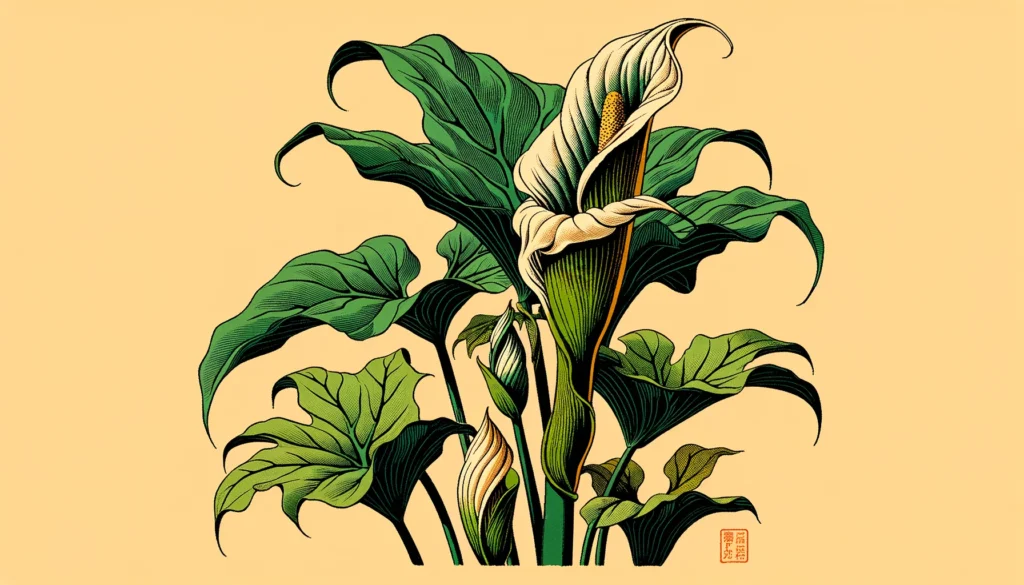

Home » Cat Plants » Could the Arum Plant Harm Your Cat?

Arum, also known as cuckoo pint or lords-and-ladies, is a toxic plant for cats. All parts of the Arum plant, including the leaves, stems, flowers, and berries, contain insoluble calcium oxalate crystals that can cause severe poisoning in felines.
The toxins present in this plant can lead to burning, swelling, and irritation of the mouth, tongue, and digestive tract. Arum plants are commonly found in woodlands, gardens, and shaded areas across Europe, Turkey, and the Caucasus region.
Ingestion may cause mild gastrointestinal upset, but is generally not life-threatening.
Ingestion can result in mild symptoms like vomiting, diarrhea, or drooling. Rarely fatal but may require veterinary care.
Eating these plants can lead to more pronounced symptoms like abdominal pain, lethargy, or difficulty breathing. Veterinary intervention may be necessary.
Ingesting even small amounts can cause severe symptoms like organ damage, seizures, or cardiac failure without rapid treatment.
All parts of these plants are extremely poisonous to cats and can quickly lead to death, even with immediate veterinary care.
** Please note: Please note that toxicity level can vary based on the amount ingested and the specific cat. It's always best to keep these plants completely inaccessible to cats and seek immediate veterinary care or call the poison hotline if you suspect your cat has ingested any part of a toxic plant.
If a cat ingests any part of the Arum plant, it may experience various symptoms due to the presence of calcium oxalate crystals.
These crystals can cause intense burning and irritation of the mouth, tongue, lips, and throat, leading to excessive drooling, vomiting, difficulty swallowing, and gastrointestinal distress.
In severe cases, swelling of the throat can occur, potentially leading to breathing difficulties.
If your cat has ingested the Arum plant, your veterinarian may diagnose them with calcium oxalate poisoning. The diagnosis process typically involves the following steps:
For more information on calcium oxalate poisoning in cats, you can refer to the ASPCA Animal Poison Control Center.

A: Cats are not allergic to arum plants, but these plants are toxic to cats. Arum plants contain insoluble calcium oxalate crystals that can cause severe irritation and inflammation if ingested.
A: Symptoms of arum plant poisoning in cats include oral irritation, intense burning and irritation of the mouth, tongue, and lips, excessive drooling, vomiting, and difficulty swallowing. In severe cases, it can also cause pain and swelling of the mouth.
A: All parts of the arum plant are toxic to cats due to the presence of insoluble calcium oxalate crystals throughout the plant.
A: If you suspect your cat has ingested any part of an arum plant, seek immediate veterinary care. Remove any plant remnants from your cat’s mouth if possible, and offer small sips of water to help rinse the mouth. Do not attempt to induce vomiting without veterinary guidance.
A: Yes, there are many pet-safe plants that cat owners can keep instead of arum plants. Some options include spider plants, Boston ferns, and catnip. Always research a plant’s safety before bringing it into a home with cats.
A: To prevent your cat from accessing arum plants, remove them from your home and garden entirely. If you must keep them, place them in areas that are completely inaccessible to your cat, such as in a closed room or high shelf. Consider using deterrent sprays or physical barriers to keep your cat away from these plants.
The Arum maculatum, commonly known as cuckoo pint or lords-and-ladies, is a tuberous herb native to Europe, Turkey, and the Caucasus region. It belongs to the Araceae family and has been cultivated for its ornamental properties. The plant has a long history and has been associated with various cultural traditions and folklore across different regions. In the British Isles, it was known by numerous common names, reflecting its distinctive appearance and potential toxicity.
Please note: The information shared in this post is for informational purposes only and should not be considered as veterinary medical advice.
🐾 A hilarious or heart-melting cat video
🐾 Our latest paws-on review of a cool cat toy